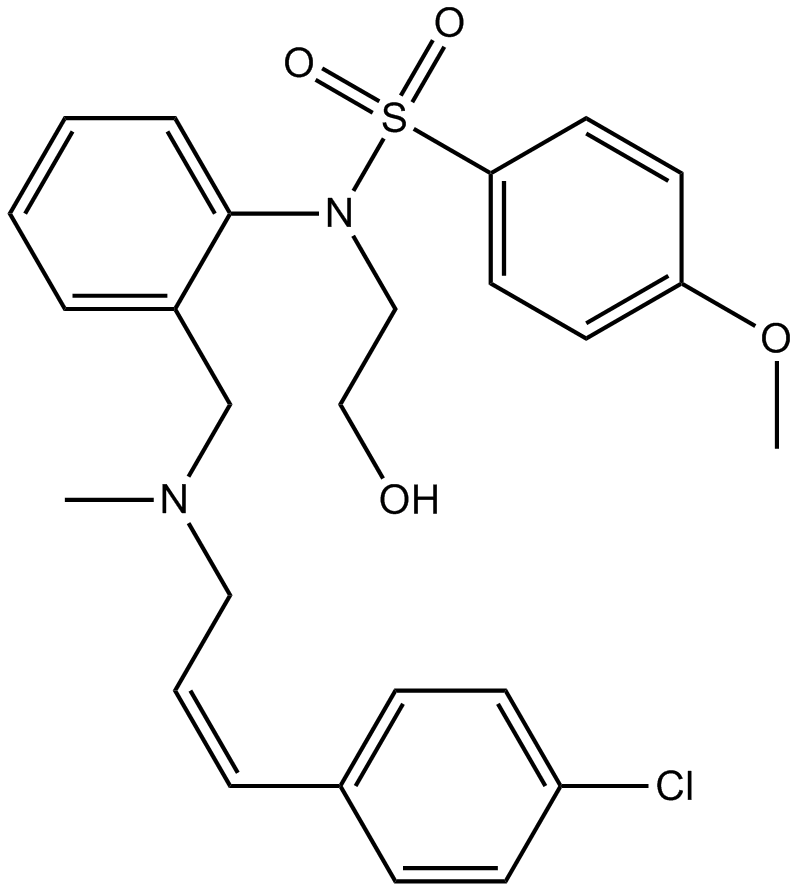KN-93 |
| Catalog No.GC10629 |
Selective inhibitor of Ca2+/calmodulin-dependent kinase type II
Products are for research use only. Not for human use. We do not sell to patients.

Cas No.: 139298-40-1
Sample solution is provided at 25 µL, 10mM.
KN-93 is a potent and selective inhibitor of CaM kinase II with IC50 value of 0.37μM.[1]
CaM kinase II means Ca2+/calmodulin-dependent protein kinase II which is a serine/threonine-specific protein kinase. It is regulated by the Ca2+/calmodulin complex. CaMKII has 28 different isoforms. The structure governs an autoinhibition which is the Threonine 286 residue. When this site is phosphorylated, it will permanently activate the CaMKII enzyme. The variable and self-associative domains of CaMKII enzyme govern the sensitivity to calcium and calmodulin. CaMKII is related to many signaling pathways. CaMKII is considered to play an important role in learning and memory. CaMKII is also important for reuptake in cardiomyocytes and Ca2+ homeostasis, and CD8 T-cell activation. Misregulation of CaMKII is considered to be related to Alzheimer’s disease, heart arrhythmia , and Angelman syndrome.[2]
KN-93 significantly inhibited CaM kinase activity at 0.5μM in vitro CaM kinase assay. KN-93 potent inhibited CaM kinase II activity In vitro CaM kinase activity with rabbit myocardium with Ki value of 2.58μM. [1] KN-93 inhibited cell growth at 12μM in NIH 3T3 cells and arrested cells in G1 cycle. KN-93 induced cell apoptosis at 24μM in NIH 3T3 cells. [3] KN-93 inhibits expression of Mcl-1which is an anti-apoptotic protein, It also induces p53-independent cell death in PCa cells. KN-93 also induces the generation of ROS and inhibits AR activity then induces cell death.
References:
[1]. Anderson ME, Braun AP, Wu Y, Lu T, Schulman H, Sung RJ: KN-93, an inhibitor of multifunctional Ca++/calmodulin-dependent protein kinase, decreases early afterdepolarizations in rabbit heart. J Pharmacol Exp Ther 1998, 287(3):996-1006.
[2]. Yamauchi T: Neuronal Ca2+/calmodulin-dependent protein kinase II--discovery, progress in a quarter of a century, and perspective: implication for learning and memory. Biol Pharm Bull 2005, 28(8):1342-1354.
[3]. Tombes RM, Grant S, Westin EH, Krystal G: G1 cell cycle arrest and apoptosis are induced in NIH 3T3 cells by KN-93, an inhibitor of CaMK-II (the multifunctional Ca2+/CaM kinase). Cell Growth Differ 1995, 6(9):1063-1070.
Average Rating: 5 (Based on Reviews and 30 reference(s) in Google Scholar.)
GLPBIO products are for RESEARCH USE ONLY. Please make sure your review or question is research based.
Required fields are marked with *




















